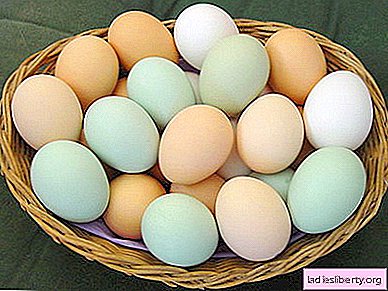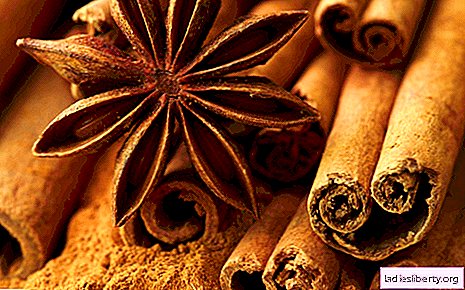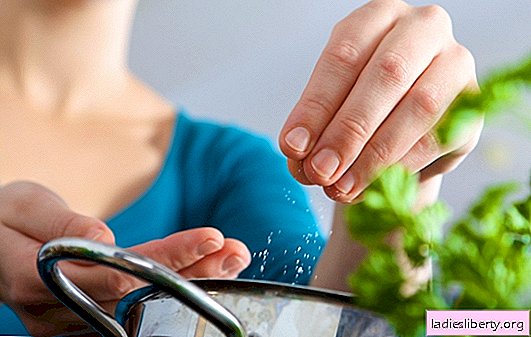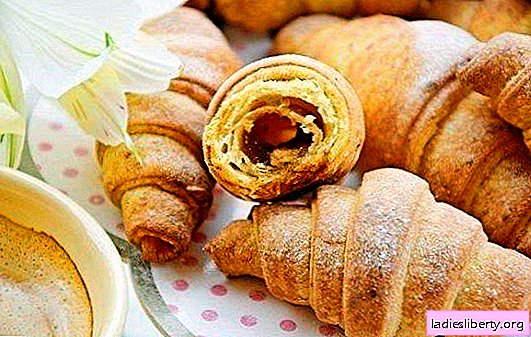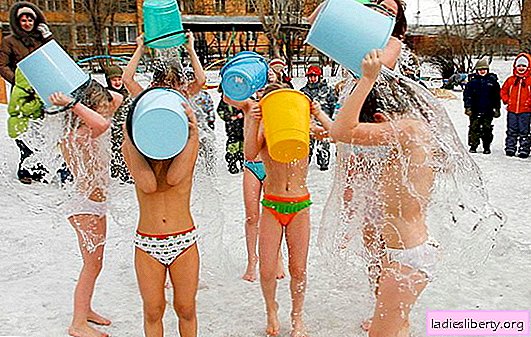
The human body does not use all the energy stored inside.
Activate latent power helps short-term "cold shock".
If you pour cold water every morning, you will be vigorous and energetic all day.
Pouring: what is it, how is it applied
There are no seasonal restrictions for wellness dousing: they are carried out all year round indoors or outdoors. The benefit of pouring is achieved when the procedure is performed correctly, therefore it is important to follow the basic rules.
Pouring is carried out in different ways depending on the purpose:
1. General douche.
When performing general pouring, a prerequisite is a change in water temperature both during one procedure and when repeating the procedures.
Pouring starts with water at a temperature of 30ºC and gradually lower to 20ºC. The general douche procedure lasts from three to five minutes and is repeated twice a day.
General douche helps with neurosis with inhibition of the nervous system, and to strengthen the body.
2. Partial dousing.
They are performed with decreasing temperature in one procedure from 30ºC to 25 ºC. The duration of the procedure is 13 minutes for any part of the body.
They are used to treat neurosis with a weakened state of the body and with the expansion of veins in the legs.
When performing partial douche, it is important to consider the effect of water on the zones of the body. The impact of a stream of water on the collar area is reflected on the organs of the chest and helps to get rid of headaches, and douche is done to eliminate the sign of rheumatism and osteochondrosis.
3. Village dousing.
The methodology for influencing the body is not very different from the soul, but the rules for the implementation are different.
Pouring is carried out from a suitable container, in the role of which can be a bucket, basin or watering can.
When dousing, a container of water is 25 centimeters from the body. During the procedure, water rolls down the body, and does not spill on the sides.
Village dousing consumes water more efficiently and brings greater results.
A serious role is played by the order in which water enters the body. First of all, water acts on the chest and back, then on the stomach and only then on the hands and feet.
It is important that the head during the general session did not get wet.
According to the localization of pouring, they are classified into:
1. Pouring over the whole body.
Includes the ingress of water on the body completely, including on the head and legs. A stream of water is directed to the spine, back of the head, to the region of the solar plexus and the place of bends of the arms and legs.
It has a calming effect, suitable for irritable people. Water is used from 15ºC to 18ºC.
2. Pouring over the top.
Water affects the body only to the waist. To prevent water from getting on your feet, a towel is tied around the lower back. First, water pours onto the right shoulder: tilt the body so that water flows from it onto the left shoulder, and then down the left hand. After that, the cervical spine, back and spine are drenched. The pouring over with the left shoulder ends, from which water flows down the right hand.
With this pouring, the head remains dry.
Pouring is suitable for people suffering from pulmonary diseases, except for the period of the acute course of the disease.
3. Pouring over the lower body.
They help people suffering from impaired bowel function and with vascular diseases of the lower extremities.
Douche begins with lumbar, then goes to the hips, feet and stomach. Before dousing, it is recommended to steam your feet.
4. Pouring back.
Helps strengthen the spine, treats osteochondrosis, improves blood circulation, restores the nervous system, normalizes sleep.
Dousing begins with a uniform stream from the nape to the heels and vice versa. After that, attention is paid to the neck, scapular region and lower back.
Pouring: what are the benefits for the body?
The principle of pouring is the difference in body temperature and water. Water, getting on the body, acts on thermal and cold receptors, while there is a reflex narrowing of the capillaries. Blood slows down the speed of movement, the temperature drops, allowing the body to save heat.
This leads to an increase in blood flow to internal organs and deep tissues. When the capillaries expand again, through the excitation of receptors, the work of the autonomic and nervous system is activated.
The flow of blood to the tissues improves the cardiovascular system and increases the tone of the neuromuscular system.
The right approach to pouring benefits the body:
1. Positively affects the complexion, tightens the skin on the body after childbirth and weight loss.
2. Improves metabolism in the body, eliminates cellulite and fat deposits.
3. Improves blood circulation, considered prevention of varicose veins and hypertension.
4. It gives energy relieves depression. Exposure to cold water affects the areas of the brain responsible for the production of norepinephrine, a hormone that suppresses depression.
5. Improves hair condition.
6. Soothes the nervous system.
7. Strengthens the immune system. If the body has adapted to daily douche, it ceases to respond to cold, so with the onset of cold and rainy days, the body will not pay attention to the damp.
Unfortunately, dousing does not guarantee protection of the body from SARS, but hardened people can more easily tolerate the course of the disease, recover quickly and do not receive complications.
Dousing: a possible health hazard?
Do not start douche with contraindications:
1. The period of exacerbation of chronic diseases.
2. Skin diseases.
3. The period of SARS and influenza.
4. Elevated eye pressure due to the risk of retinal detachment.
5. Heart disease: tachycardia, ischemia, heart failure.
6. Hypertension.
7. Tuberculosis in an open form.
8. Diseases of the genitourinary system.
9. Oncological diseases.
10. Epilepsy.
11. Atrial fibrillation.
12. Diseases of the thyroid gland.
13. Past stroke or heart attack.
14. Thrombophlebitis.
Partly dousing is harmful, as the rush of vigor felt after the procedure is due to the release of adrenal hormones. Regular stimulation of their work is addictive and exhausting. An excess of hormones in the body increases the thrombosis of blood vessels and capillaries.
Dousing, like other wellness treatments, requires accuracy and enforcement. If there are no obvious diseases, but health cannot be called good, previously consult a doctor, so as not to inflict harm on the body by pouring.
For pregnant and lactating mothers: are douches useful?
When performing douche during pregnancy, remember the health of the baby. With the wrong approach, there is a risk of a cold, which is extremely undesirable during this period.
Pregnant women are recommended to douche their legs, which prevents varicose veins.
To do this, water flows from the knee or thigh down to the foot.
Such dousing helps improve blood circulation in the limbs, relieves feelings of fatigue and heaviness in the legs. Cold increases the tone of veins and blood vessels, preventing their appearance.
Dousing during pregnancy is useful for both the expectant mother and the baby. The only caveat is that showering is for healthy women only.
Pregnancy in itself is not a contraindication to douche, but if dousing was not practiced before pregnancy, this period is not suitable for starting. During pregnancy, the body tolerates heavy loads and it is not worth burdening this period.
If douche was practiced before pregnancy, it should not be stopped with its onset.
Another argument in favor of douche is an increase in lactation, therefore, if a young mother is healthy, but has problems with feeding, douche will benefit the body.
Dousing for children: useful or harmful
Watering children is a sure way to temper them. It is widely believed that children should not be tempered before the age of one, since temperature differences are harmful to babies. In fact, the baby already experienced the first hardening at the moment of birth, having fallen from the mother’s body with a temperature of 36.6ºC into a room with a temperature of 25ºC and feels healthy. Therefore, if the baby’s development proceeds normally, he eats, gains weight and does not show serious problems with the nervous system, feel free to start dousing.
A small child is doused with cool water (35ºC) immediately after bathing. When it warms up, re-pouring starts from the heels, the water is used colder by 7-10ºC. After that, it is wrapped in a diaper, without wiping. The pouring temperature drops by a degree every three days, note that below 20ºC do not lower the temperature.
Older children undergo douche in the form of a contrast shower. The child must first warm up in warm water, after which the feet, palms and collar zone are poured with cold water. After dousing, the child again gets up under a warm shower. Repeating these steps is recommended five to seven times. The main thing is to start with warming the body, and end with dousing.
In no case should you shower your children with a cough or fever. When the child recovers, you need to accustom to pouring from the beginning. Begin dousing your feet with water at room temperature, gradually lowering the temperature.
Watering is good for the health and development of children, but it is imperative It is worth adhering to four principles:
1. The systematic conduct of the pouring.
2. A gradual increase in time.
3. For a child, pouring should not be a surprise. The child should never be scared - this injures his nervous system. Explain to him the principle of the procedure, imagine dousing in a playful way.
4. Do not douche if the child is cold. Avoid hypothermia.


